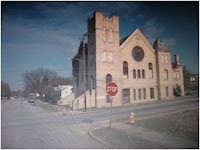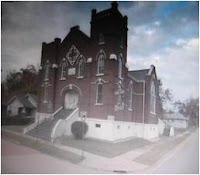A collage of images of Ft. Smith. All images represent African American History
My home is western Arkansas, on the banks of the Arkansas River. Ft. Smith Arkansas is a city rich in history and I have a strong appreciation for the rich history of the black population that occupied this frontier town.
From the earliest days, Ft. Smith was a city that had people of color, and in fact free people would occupy the land before slavery was introduced to the area. One of the earliest residents was recorded in the first census taken in the state--which was 1840.
Ft. Smith 1840 Census. Names at very bottom were free people of color. In this image John Turner & Peter Colder were among the city's first residents. Both were free people of color.
Two of the earliest known black residents of the city in 1840
Civil War
And the story cannot be told without telling the story of the Civil War, and the regiments that came through Ft.
Smith. One black regiment was organized in Ft. Smith---the 11th US Colored Infantry. I shall commit myself to telling the stories of the Black Union men and the Black Union regiments that served in Ft. Smith.
Document from Military Service Record of Theodore Anderson who joined the Union Army in Ft. Smith in March 1864, entering the 11th US Colored Infantry. Source: National Archives Military Service Records
Photographed by Tonia Holleman of Van Buren, Arkansas
BLACK FRONTIER HISTORY
With Ft. Smith being a frontier town, the richness is strong in the history of the US Marshals who served out of Judge Parker's Court. The most famous was Bass Reeves, but there were many other African American men who also rode for Judge Parker as US Deputy Marhsal.
Bass Reeves, US Deputy Marshal
Neely Factory one of Judge Parker's Deputy Marshals
Photo from Collection of Tonia Holleman
Many who know the history of Judge Parker also point out that the bailiff of his court was George Winston an educated man who moved to Ft. Smith after the Civil War.
George Winston, Bailiff in the Court of Judge Isaac C. Parker
EDUCATION
Education has been the goal since Freedom came. Educators for Freedman schools came from Ohio and by the 1890s the city had a high school. Judge Isaac Parker gave out the diplomas for the first graduating class in 1892. The first principal was Prof. E. O. Trent from an educated family of free blacks of Ohio.
Prof. E. O.Trent, first black high school principal
Mahulda Arrington, first black female permanent teacher in Ft. Smith
Source: Sidney Rowell Reynolds
When Lincoln High School was built it was a red brick building. It was later painted white to the image that most people recognize.
Source: Gene Mccluney Ft. Smith
The main building at Lincoln High School in the years before it was closed
Source: Gene Mccluney, Ft Smith
CHURCHES:
There are many beautiful churches old and new in the city, and they stand as places that held the community together over the past 140 years. The denominations cover a wide range from Baptist to Methodist to Catholic, Church of God, Seventh Day Adventist, all were found in the Black community of the city! Theirs is a rich legacy of a diverse people within the smaller community. Some of the older buildings, stand and still hold services and some have closed and now only the tree lined streets speak the sweet hymns of the past.
Malalieu Methodist Church, now closed was one a major part of the religious pulse of the community.
Though now closed the structure, though fragile, still stands on North 9th street
This beautiful old structure is Quinn Chapel AME. Services still continue at this church after 140 years.
From 1917 to 1967, this was the only all black Catholic Parish in Western Arkansas.
A parish school was also a part of the community and both closed in 1967.
The history of my community is a rich one, and my goal is to continue to share the wonderfully rich stories from this community as well as others that I have had the opportunity to study and learn about over the past 20 years.
As today is the beginning of Black History Month, I appreciate the history of people large and small, and their contributions to the growth of a community. History is sometimes the story of the famous, but for me it is the story of the communities and their people from which we can all be proud.















9 comments:
Fantastic article. Thanks for sharing.
Best wishes,
http://www.resurrection-mission.com
http://www.lulu.com/jackrobinson
Thanks so much, Jack! People like yourself who are working so diligently in their own communities are part of the reason that I also do what I do. All of us must work to tell our stories.
Hi Angela,
Tell me something, I was just looking at some Choctaw Freedmen Dawes cards and came across the name Neely Factor. It this the same person you write about in your article?
I knew when I saw the name it was familiar but I couldn't put it together at the time.
Yes, Nelly Factor and Neely Factory are the same person. The family goes by the name Factory, today. His record as a US Marshal, always calls him Factor, but in one of the interviews it was pointed out that the family name was truly Factory.
Hi Angela,
You've packed more pictures onto this one post than I have on my entire blog. Each one of them is a story unto itself, I'm sure.
A few years ago I translated a poem called Little Rock. It was written in German by the colonel who commanded my great great grandfather's regiment, the 27th Wisconsin, during the Civil War. You have to read nearly the whole poem before you realize his point of view or vantage point. He's on top of a hill or mountain near Little Rock with a panoramic view of the Arkansas River and much of the poem is about the river.
The unit occupied Little Rock from August 1863 until February 1865. The structure of the first half of the poem is essentially a calendar, providing a brief mental picture of each month as it passes. I've never been to Arkansas, but I really enjoyed translating the poem.
I feel like I could use some technical assistance on my translation. I need advice from a reader whose German is much better than mine and I need a reader who knows Arkansas. Please let me know if you know someone who could help me with one thing or the other.
Angela,
My name is Andria and I enjoyed your blog! I was searching the internet for additional information on my family to share with my children.
I am the great grand daughter of Alphonso Trent, the musician and the great great grand daughter of Professor E.O. Trent so I enjoyed seeing him on your blog! Keep up the good work and God bless :)
How wonderful that you have found the blog and found the article about the Trents! You have an amazingly rich family history and in fact, I have info on the family that extends before the Civil war into Ohio. E. O. Trent and his family were free people of color that migrated to Ohio in the 1840-50s. And of course his son Alphonso was a legend on hiw own. Do stay in touch as it is a pleasure to hear from a descendant of this amazing family!
Hi Angela!
My name is Sierra Bennett and Neely Factory is my Great Great Grandfather! I got his name from my grandparents Lois and Everett Phifer and my great-grandmother Wilma Factory, which is his daughter. I've always heard my family members talk about him when I was younger, but I didn't know how important he was in the African American History. This information has helped me complete my Genealogy Quest project for my Afro-American Art class. Thank you!
Hello Angela thanks for posting my great great Grandfather Neely Factor. Nelly Factor is a Indian half black women around 1830 her husband was John Blount... Apart of the first Seminole wars ..there were also from her Sam Factor, Dembo Factor, Hardy Factor and his son Pompey Factor. These are said as I know to be distant cousin's. Thanks so much for your work. Books like Dreaming with the Ancestors, changing the face of early captivity and more.
Post a Comment